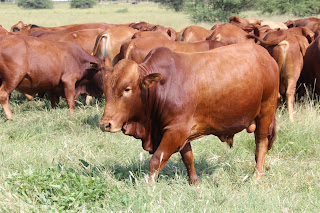Coming into our last day in South Africa, we woke up early
and loaded up the van by 7:15 AM with our bags packed up. We ventured off on a
two hour drive to Pilanesberg National Park. When we arrived, we loaded up on a
safari truck and went on a three hour safari through the park! We were very
lucky to see most of the animals they had in the park and got some great close-up
pictures. We were able to see impalas, kudu, wildebeest, zebras, rhinos,
warthogs, nyalas, giraffes, an elephant, and a few baboons as well. A memorable
experience none of us will forget is running into a “traffic jam” with the
oldest and most aggressive elephant in the park (55 years old). Don’t worry, we
were very cautious and kept our distance from him.
We not only got to see the animals, but we also learned some
interesting facts about a few of them. For example, we learned how to tell the
difference between a female and male giraffe; males’ horns have more fur, are
darker in color, and are typically found on their own. A fun fact we learned
about zebras is that they like to stay in herds with wildebeest, because the
wildebeest are not as intelligent and serve as a protection for the zebras
against predators. We also found out that warthogs are efficient grazers. They
are known for their short neck; therefore, when they have their head down while
they are grazing their neck gets tired. When this happens, they will actually
kneel down to eat. We learned so much during the safari and it will be an
outstanding memory in all of our minds forever.
We headed back to the hotel to drop off Mike MacNeil, our
fearless trip leader who generously connected us with our South African
experience. We would like to thank Mike for all that he has done for us in
regards to planning and helping us around the beautiful country of South
Africa. We also dropped off Amy Abrams at the hotel (graduate student). This is
a fun surprise for all of us as she will be investigating a potential job
opportunity. We couldn’t be more happy and excited for her! Good luck, Amy!
We proceeded to the airport where we all made it through
just fine to the gates. Our plane will depart at 11:55 PM tonight and we will
be connecting in Amsterdam 11 hours later. We will then fly to Minneapolis and
to Sioux Falls and should be back in Brookings late Sunday night.
We all had such an amazing and life changing experience and
we couldn’t be more grateful for our professors who willingly took us abroad.
Thank you so much Dr. Walker and Prof. Gonda! We appreciate all of your
guidance and knowledge throughout the whole trip. To the parents and friends
who have been following our blog, thank you for allowing us to be a part of
such a trip and we also appreciate all of your support and love!
We are all looking forward to the welcoming snow and cold of
the Midwest. ;) Spring break 2019 will be one for the books.
Zebra
Wildebeest
Rhino, a very lucky find so close to the road!
An elephant traffic jam!!
The same elephant off the road.
Giraffe































